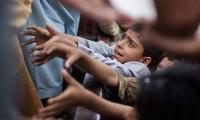Delhi dubbed ‘rape capital’; 37,413 cases reported in country in 2014; crimes against women have increased by 200 per cent since 2012
LAHORE: Although unabated rape incidents have been a regular feature across the length and breadth of India for ages, a spate of cases involving sexual molestation of very young children in recent past has literally stunned, horrified and shocked the residents of the world's largest democracy, where 13,766 such cases were reported in 2014, 12,363 in 2013 and 8,541 in 2012.
Overall, according to the Indian National Crime Records Bureau, 89,423 cases of crimes against children were reported in the country during 2014. Research conducted by the “Jang Group and the Geo Television Network” reveals that while nearly one in three rape victims was below the age of 18 years in India during 2014, 12.5 per cent of total or 3,125 rape victims happened to be minors.
One in 10 of the raped Indian females are under 14 and every 20 minutes, a woman is raped in the country that boasts highly of its magnificence, history, architecture and cultural values! According to the Indian National Crime Records Bureau, whose offices are attached to the Ministry of Home Affairs in New Delhi, the total number of rape cases in India for the year 2014 had stood at 37,413.
However, only 4,944 people were convicted for rape, whereas a whopping 12,705 accused were acquitted in 2014. Apart from rapes, the country had recorded nearly 34,000 murders by August 2015 and there were 66,000 incidents of rioting.
In 2014, 131,666 people had committed suicide in India and two South Indian states- Tamil Nadu and Karnataka-had earned the dubious distinction of being the states with the highest incidence of child marriage in the country in 2014.
Remember, sexual assault in India is dramatically underreported as victims keep mum due to fears of being shamed and smeared. In its August 19, 2015 edition, a top Indian newspaper “The Hindu” had viewed: “For the first time in history, Delhi is officially the “rape capital” of India. Even while the pace of increase in the number of reported rapes in the city has slowed down, the number of such cases proportionate to its women population was higher than for any other city or State last year.
Analysing the data released by the country's National Crime Records Bureau, “The Hindu” had written: “During the past years, Delhi reported a larger actual number of reported rapes than other cities, but cities in Madhya Pradesh, including Gwalior and Jabalpur, reported higher numbers of rapes proportionate to their populations. This year, Delhi is higher in both absolute and proportionate terms.”
It had reported: “The city reported 1,813 rapes in 2014, up from 1,441 in 2013. While Delhi continues to lead other big cities in the number of reported rapes, the increase in reported cases has tapered after a sharp spike in 2013. In Mumbai, in contrast, while the number of reported rapes was comparatively lower, there was a sharp spike between 2013 and 2014, from 391 to 607 cases. Nearly all of India’s custodial rape — 189 of 197 cases — was reported in Uttar Pradesh, which along with Rajasthan and Madhya Pradesh recorded the highest numbers of alleged gang rapes.”
The premier Indian media house had added: “For the country as a whole, as the number of reported crimes against women increased to over 3.3 lakh, or 56 incidents per lakh women, the rate of increase has tapered off. There was a sharp rise in reported crimes against women between 2012 and 2013, as a result of increased awareness following the December 2012 gang-rape, but the increase was sharply lower between 2013 and 2014, the police say. While the share of reported rape cases in which the offender was known to the victim remained significantly high at 86 per cent, it was substantially lower than in past years, when the proportion was 94 per cent or higher.”
Rape, the fourth most common crime against women in all Indian cities is thus haunting Premier Narendra Modi's “Shining India” despite the passage of the Criminal Law (Amendment) Act, 2013 in March 2013.
This law was enacted following protests in the widely-publicised December 2012 Delhi gang rape when a 23-year-old female student Jyoti Singh was sexually molested in a private bus by six men.
Jyoti had succumbed to her injuries in a Singapore hospital on December 29, 2012 and the globally-condemned gory incident had generated widespread national and international coverage. Several new laws were passed and six new fast-track courts were created to hear rape cases, but to no avail.
A leading Indian newspaper “India Today,” while quoting Union Minister of Women and Child Development Maneka Gandhi's statement in the Lok Sabha last year, had added: “As per the available data, a total of 8,904 cases were registered under the Act during 2014. Sections 28, 32, 33, 35, 36 and 37 of the Protection of Children from Sexual Offences (POCSO) Act provide safeguards for protecting the children at every stage of judicial processes by incorporating child-friendly mechanisms for speedy trial of offences in designated special courts. However, child rights activists have been expressing concern over the lengthy legal process in such cases.”
However, the 30-year old National Crime Records Bureau of India, which has estimated that crimes against women have increased by 200 per cent since 2012, had come up with much higher firgures for 2013.
“The Indian Express” had highlighted this report too. In its 2014 report, the National Crime Records Bureau had stated: “There were 33,764 victims of rape out of 33,707 reported rape cases in the country during the year 2013. And 13.1 per cent (4,427 out of 33,764) of the total victims of rape were girls under 14 years of age, while 26.3 per cent (8,877 victims out of 33,764) were teenage girls (14–18 years). Not less than 46.1 per cent (15,556 victims) were women in the age-group 18–30 years. However, 13.8 per cent (4,648 victims) victims were in the age-group of 30–50 years while 0.7 per cent (256 victims) were over 50 years of age.”
The Bureau had further revealed: “As many as 24,923 rape cases were reported across India in 2012, while the five-year average over 2007-2011 was 22,000 rapes per annum. Adjusted for population growth over time, the annual rape rate in India has increased from 1.9 to 2.0 per 100,000 people over 2008-2012 period. This compares to a reported rape rate of 1.2 per 100,000 in Japan, 3.6 per 100,000 in Morocco, 4.6 rapes per 100,000 in Bahrain, 12.3 per 100,000 in Mexico, 24.1 per 100,000 in United Kingdom, 28.6 per 100,000 in United States, 66.5 per 100,000 in Sweden and world's highest rate of 114.9 rapes per 100,000 in South Africa. Adjusted for population, the rape rate per 100,000 women in 2013 was highest in Delhi (20.per lakh), followed by Mizoram (15.8 per lakh), Andaman and Nicobar Islands (14.9 per lakh), Sikkim (14.7 per lakh) and Tripura (12.6 per lakh). The rape rate per 100,000 women in 2013 was lowest in Bihar, followed by Gujarat, Tamil Nadu, Pondicherry etc.”
It had further held in 2013 that 24,923 rape cases were reported across India in 2012. Out of these, 24,470 were committed by someone known to the victim.
In 2012, out of 1,01,041 cases before Courts, 3,563 convictions took place in comparison to 11,154 acquittals and 292 cases withdrawn.
The already over-burdened Indian courts had completed the trial process of an estimated of 14,717 rape cases in 2012, while many cases remained pending in its trial process.
Although 2015 figures are not yet available, they are expected to be much worse than 2014.
Just days ago, a minor was raped and killed in the state of Madhya Pradesh by a man who used to work for victim's father.
Just to cite a couple of the hundreds of such cases, another child was allegedly gang-raped by two of her neighbours in outer Delhi on September 15, 2015.
Angry locals had beaten up the two accused after shaving off their heads.
In October 2015, two teenagers were arrested for the alleged abduction and rape of a two-and-a-half year old girl, who had gone missing from outside her home in Western Delhi.
In May 2014, two teenagers were gang-raped in Uttar Pradesh. The unfortunate girls were later found hanging from a tree.
Even the elderly women are not spared.
On March 14, 2015, a 71-year-old nun was allegedly molested in West Bengal by intruders at the Convent of Jesus and Mary. The CCTV footage showed the culprits ransacking the chapel, destroying religious items, looting cash and the gang raping the poor nun.
Rape cases against female foreign visitors, tourists and professionals have led several countries to issue travel advisories that women travellers should exercise caution when travelling to India.
In November 2015, a 23-year-old Russian national suffered an acid attack in Varanasi,
In September 2015; an American woman was gang-raped in Dharamshala. The 46-year-old Californian woman was visiting Dharamsala, the home of Dalai Lama, when she was grabbed by two men and assaulted.
In January 2015, six local men in Kolkata were charged with kidnapping and gang-raping a 22-year-old Japanese tourist. The woman was allegedly held hostage for a month after travelling to the Buddhist shrine of Bodh Gaya in Bihar state.
In February 2015, a Japanese girl was raped in Jaipur by a tour guide. She had accused the local guide of drugging and then raping her.
According to the AFP, the woman said she was given food laced with drugs before being attacked by the man thought to be aged about 25.
Last year, Britain and France had revised their travel advisories for India, whereby warning their citizens about the risk of sexual attacks.
In January 2015, six men from the eastern city of Kolkata were charged with kidnapping and gang-raping a 22-year-old Japanese tourist.
The woman was allegedly held hostage for a month after travelling to the Buddhist shrine of Bodh Gaya in Bihar state.
In January 2014 a 51-year-old Danish tourist was robbed and gang-raped at knifepoint in New Delhi.
In March 2013 a Swiss cyclist holidaying in the central state of Madhya Pradesh was robbed and raped by five men, all of whom were later jailed for life. The woman and her husband, who were cycling to Agra, said they were attacked by six men as they camped en route. The husband was tied up and the woman was raped.
Also in March 2013, a 31-year-old British woman had told police she had to jump from the balcony of her second-floor Agra hotel room to escape harassment by the manager of the hotel and another man. The hotel manager and a security guard were charged with attempted sexual offences and taken in to judicial custody.
In February 2013, a Chinese woman had filed a police complaint against a man who allegedly raped her after the two had met at a south Delhi party.
In June 2013, an Irish woman had filed a complaint with police in Kolkata against a man who had allegedly raped her after the two met at her birthday party.
The woman used to volunteer at a children’s charity in the city.
Just before this incident, the Irish Department of Foreign Affairs had updated its travel advisory for India.
The Irish advisory had stated: “Women should use caution when traveling in India. Recent sexual attacks against female visitors in tourist areas and cities show that foreign women are at risk.”
In June 2013, an American woman was raped by three men near the northern Indian town of Manali. Police said the 30-year-old had accepted an offer from a truck driver to take her from a small village to her guesthouse, and was raped by the driver and two others after she boarded the truck.
All these afore-cited incidents were reported by reputed British and American newspapers like the Telegraph, the Guardian and the Wall Street Journal etc.
In 2013, this is what “The Guardian” had viewed: “Though officials stress that such cases are infrequent and that millions of visitors travel through India every year, the growing problem has hit tourism. The number of foreign tourists arriving in the country dropped by 25 per centy during the first three months of 2013, largely because of fears about the risk of sexual assault.”
According to official data, more than 132,000 cases of sexual violence against women were reported in the country of 1.3 billion.
In January 2015, the Tourism Ministry of India had introduced emergency help lines in 12 foreign languages for female tourists, later announcing in April 2015 that tourists would be given a “welcome card” by the immigration officer on arrival with resources to ensure their safety.
The Indian government had also pledged that GPS-embedded tracking system would be introduced in all taxis and for tourists.







